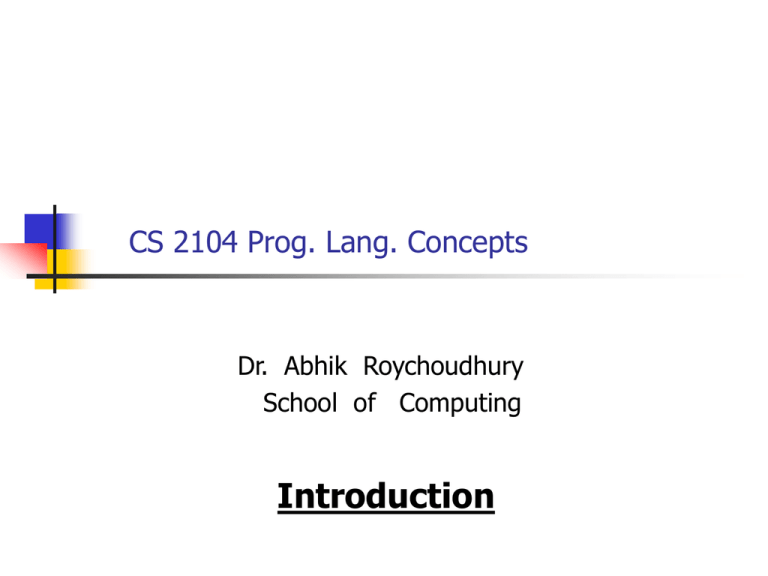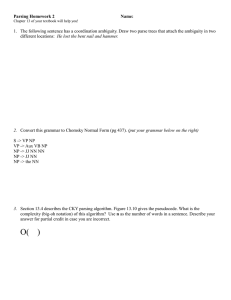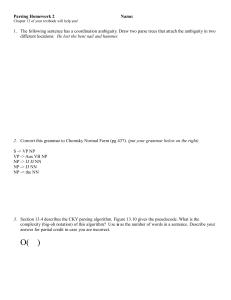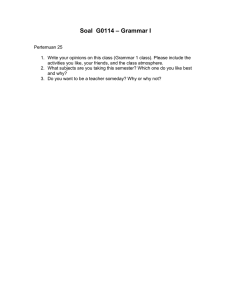Language Syntax
advertisement

CS 2104 Prog. Lang. Concepts
Dr. Abhik Roychoudhury
School of Computing
Introduction
Learning Objectives
Familiarity with the key concepts underlying
modern programming languages.
Highlight the similarities and differences between
various programming paradigms.
Ability to choose a programming paradigm or
program construct given a problem scenario.
Course Focus
More on the concepts of programming.
Less on individual prog. Languages.
More on clean programming styles.
Less on specific programming tricks.
Topics
Basics of program syntax and semantics.
Elementary and structured types
Subprograms
Abstract Data types, Inheritence, OO
Functional and Logic Programming
Type Checking/Polymorphism
Assessment
10 Homeworks : 20%
Midterm : 25%
Tutorial participation : 5%
Final examination : 50%
Textbook
Programming Languages
Allen Tucker and Robert Noonan
McGraw Hill Publishers
Available in Bookstore
Textbook changed from last year.
Course Workload
Weekly homeworks : 2-3 hrs.
Weekly reading : 4-5 hrs.
Lecture : 2 hrs.
Tutorial : 1 hr.
TOTAL : 10 hrs. (approx)
Workload reduced from last year
The people
You
TA : Soo Yuen Jien
Instructor :
Dr. Abhik Roychoudhury
Look up the course web-page
http://www.comp.nus.edu.sg/~cs2104/
Keeping in touch
Post a message to the IVLE discussion forum
Course code
CS2104
Send e-mail to cs2104@comp.nus.edu.sg
Meet lecturer/TA during consultation hours.
Announcements posted in the course web-page:
http://www.comp.nus.edu.sg/~cs2104/
Coming to class….. Might want to consider it
CS 2104 Prog. Lang. Concepts
Reading: Textbook chapter 2.1 - 2.3
Dr. Abhik Roychoudhury
School of Computing
Language Syntax
Program structure
Syntax
What a program looks like
BNF (context free grammars) - a useful
notation for describing syntax.
Semantics : Meaning of a program
Static semantics - Semantics determined at
compile time:
var A: integer; Type and storage for A
Dynamic semantics - Semantics determined
during execution:
X = ``ABC''
X a string; value of X
Formal study of syntax
Programming languages typically have common building blocks:
Identifiers
Expressions
Statements
Subprograms
Need to formally specify how a “syntactically correct” program is
constructed out of these building blocks.
This need is satisfied by BNF grammars. It is simply a notation
which allows us to write how “synt. Correct” programs are
constructed.
An Example
A grammar for arithmetic expressions (common in programming
languages)
<E> ::= <E> + <E>
<E> ::= <E> *<E>
<E> ::= ( <E> )
<E> ::= <Id>
Assuming a,b,c are identifiers
(a + b) is an expression
(a + b) * c is an expression
All arith. Expressions with addition and multiplication can be generated
using the above rules.
Study of Grammars
Grammars simply give us rules to generate the syntactic
building blocks of a program e.g. expressions, statements.
We saw an example of a grammar for expressions.
The rules in the grammar can be applied repeatedly to generate
all possible expressions. These expressions are called the
language of the grammar.
Furthermore, given an expression, the grammar could be used
to check whether it can be generated using its rules. This is
called parsing.
Let us now study BNF grammars more carefully.
BNF grammars
Nonterminal: A finite set of symbols:
<sentence> <subject> <predicate> <verb>
<article> <noun>
Terminal: A finite set of symbols: the,
boy, girl, ran, ate, cake
Start symbol: One of the nonterminals:
<sentence>
BNF grammars
Rules (productions): A finite set of replacement
rules:
<sentence> ::= <subject> <predicate>
<subject> ::= <article> <noun>
<predicate>::= <verb> <article> <noun>
<verb>
::= ran | ate
<article> ::= the
<noun>
::= boy | girl | cake
Replacement Operator: Replace any nonterminal by a
right hand side value using any rule (written )
Empty strings
How to characterize strings of length 0? –
In BNF, -productions: S SS | (S) | () |
Can always delete them in grammar. For example:
X abYc
Y
Delete -production and add production without
:
X abYc
X abc
Example BNF sentences
<sentence> <subject> <predicate> First rule
<article> <noun> <predicate>
Second rule
the <noun> <predicate>
Fifth rule
... the boy ate the cake
Also from <sentence> you can derive
the cake ate the boy
Syntax does not imply correct semantics
Note: Rule <A> ::= <B><C>
This BNF rule also written with equivalent syntax:
A BC
Language of a Grammar
Any string derived from the start symbol is a
sentential form.
Sentence: String of terminals derived from start
symbol by repeated application of replacement
operator
A language generated by grammar G (written L(G)) is
the set of all strings over the terminal alphabet
(i.e., sentences) derived from start symbol.
That is, a language is the set of sentential forms
containing only terminal symbols.
Derivations
A derivation is a sequence of sentential
forms starting from start symbol.
Grammar: B 0B
Derivation: B
Each step in the
application of a
| 1B | 0 | 1
0B 01B 010
derivation is the
production rule.
Parse tree
A parse tree is a hierarchical synt.
structure
Internal node denote non-terminals
Leaf nodes denote terminals.
Grammar: B 0B | 1B | 0 | 1
Derivation: B 0B 01B 010
From derivation get parse tree
as shown in the right.
Derivations
Derivations may not be unique
S SS | (S) | ()
S SS (S)S (())S (())()
S SS S() (S)() (())()
Different derivations but get
the same parse tree
Ambiguity
Each corresponds to a unique derivation:
S SS SSS ()SS ()()S ()()()
But from some grammars you can get 2 different parse
trees for the same string: ()()()
A grammar is ambiguous if some sentence has 2
distinct parse trees.
Why Ambiguity is a problem
BNF grammar is used to represent language constructs.
If the grammar of a language is non-ambiguous, then we can
assign a unique meaning to every program written in that
language.
If the grammar is ambiguous, then a program can have two or
more different interpretations.
The two different interpretations of a given program will be
shown by the two different parse trees constructed from the
grammar.
Exercise 1
Is the grammar of arithmetic expressions shown earlier an
ambiguous grammar ? Try to construct a derivation with two
different parse trees.
<E>
<E>
<E>
<E>
::=
::=
::=
::=
<E> + <E>
<E> *<E>
( <E> )
<Id>
Exercise 1 - Answer
<E>
<E>
<E>
<E>
::=
::=
::=
::=
<E> + <E>
<E> *<E>
( <E> )
<Id>
2+3*4
E
E
E
Id
2
+
Id
3
E
*
E
Id
Id
4
2
+
*
E
Id
Id
3
4
Extended BNF
This is a shorthand notation for BNF
rules. It adds no power to the
syntax,only a shorthand way to write
productions:
[ ] – Grouping from which one must be
chosen
Binary_E -> T [+|-] T
{}* - Repetition - 0 or more
E -> T {[+|-] T}*
Extended BNF
{}+ - Repetition - 1 or more
Usage similar to {}*
{}opt - Optional
I -> if E then S | if E then S else S
Can be written in EBNF as
I -> if E then S { else S}opt
Extended BNF
Example: Identifier - a letter followed by 0 or
more letters or digits:
Extended BNF
Regular BNF
I L { L | D }*
L a | b |...
D 0 | 1 |...
I
M
C
L
D
L | L M
CM | C
L | D
a | b |...
0 | 1 |...
Exercise 2:
BNF and EBNF are convenient notations for writing
syntax of programs.
Try to write both the BNF and the EBNF descriptions
for the switch statement in Java.
Remember that your description must generate
All syntactically correct switch statements
No other statements.
Parsing
BNF and extended BNF are notations for formally
describing program syntax.
Given the BNF grammar for the syntax of a
programming language (say Java), how do we
determine that a given Java program obeys all the
grammar rules.
This is achieved by parsing.
We now discuss a very simple parsing algorithm to
give an idea about the process.
Recursive descent parsing
overview
A simple parsing algorithm
Shows the relationship between the
formal description of a programming
language and the ability to generate
executable code for programs in the
language.
Use extended BNF for a grammar, e.g.,
expressions:
<arithmetic expression>::=<term>{[+|-]<term>}*
Recursive descent parsing
<arithmetic expression>::=<term>{[+|-]<term>}*
( Each non-terminal of grammar becomes a procedure )
procedure Expression;
begin
Term; /* Call Term to find first term */
while ((nextchar=`+') or (nextchar=`-')) do
begin
nextchar:=getchar; /* Skip operator */
Term
end
end
Partially Completed Recursive
Descent Parse for Assignments
Summary
We need a “description language” for describing the
set of all allowed programs in a Prog. Lang.
BNF and EBNF grammars are such descriptions.
Given a program P in a programming language L and
the BNF grammar for L, we can find out whether P is
a syntactically correct program in language L.
This activity is called parsing.
The Recursive Descent Parsing technique is one such
parsing technique.






